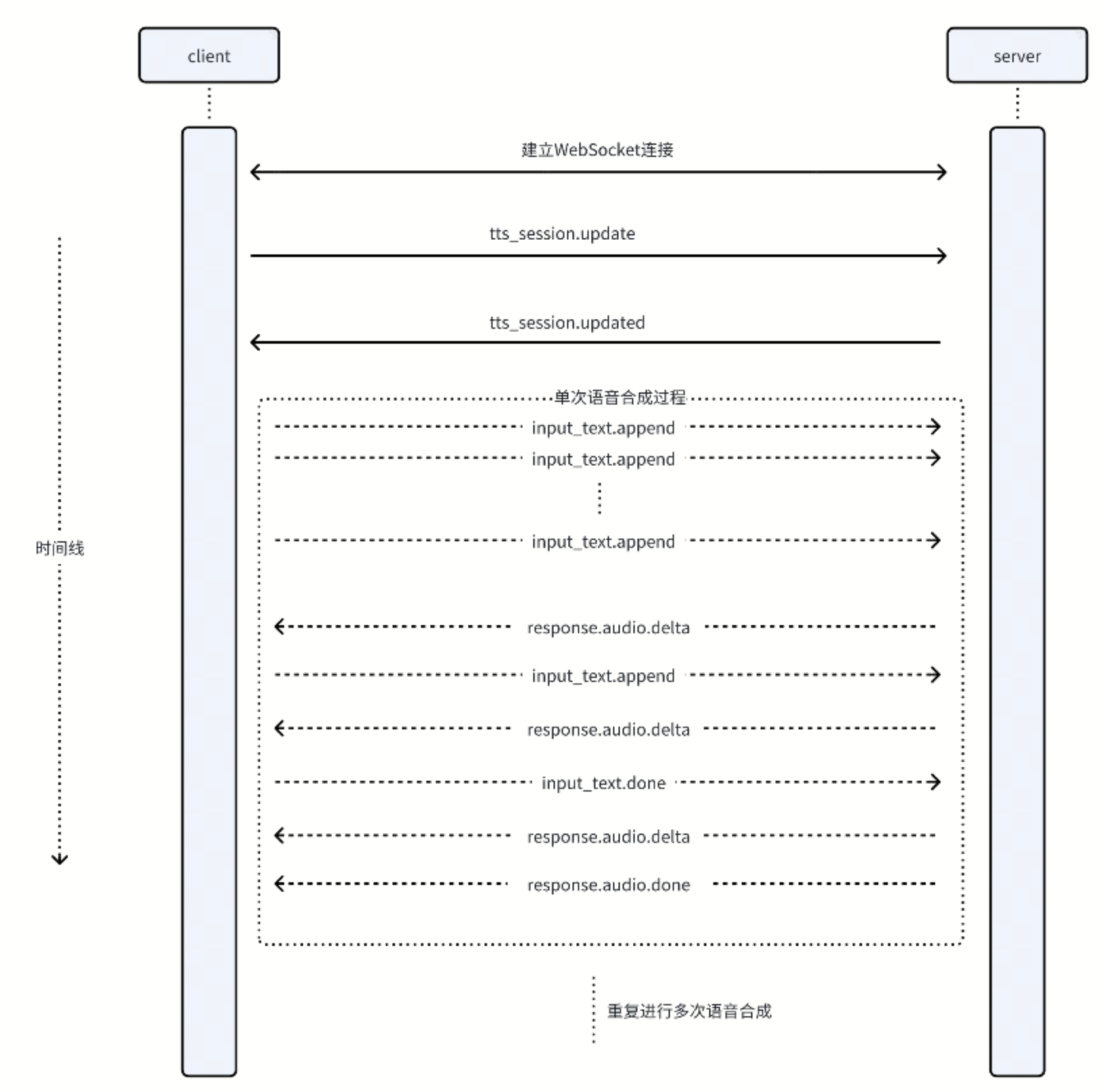本文档介绍如何通过火山引擎边缘大模型网关,使用有状态、基于事件的 Realtime API 来调用您自部署的语音合成(TTS)模型。
概述
Realtime API 通过 WebSocket 协议进行通信,适用于需要低延迟、实时流式传输的场景。它允许客户端与服务端建立持久连接,并在此连接上进行双向的事件驱动通信,从而实现将文本数据实时合成为音频流。
建连参数
与 Realtime API 建立 WebSocket 连接时,需要指定以下参数:
URL:
wss://ai-gateway.vei.volces.com/v1/realtime查询参数:
?model=<your_model_name>请求头 (Header):
Authorization: Bearer $YOUR_API_KEY
快速开始
本节将引导您完成一次完整的 API 调用,从建立连接到接收合成的音频。
准备工作
在开始之前,请确保您已获取以下信息:
模型调用名称 (
<your_model_name>):在 大模型管理 页面获取。API 密钥 (
$YOUR_API_KEY):在 网关访问密钥 页面获取。说明
请确保该密钥已绑定您的自部署 TTS 模型。关于如何绑定自部署 TTS 模型,请参见 调用自部署模型。
步骤 1:编写调用代码
以下是一个完整的 Python 示例,展示了如何连接到 Realtime API、发送文本并接收音频流。
创建一个名为
requirements.txt的文件,并填入以下依赖:numpy soundfile scipy websockets==12.0 openai创建一个名为
tts_client.py的文件,并将以下示例代码粘贴进去。说明
- 注意将代码中的
<your_model_name>和$YOUR_API_KEY替换为实际值。 - 以下示例代码仅用于测试,请勿用于生产环境。
import asyncio import base64 import json import numpy as np from scipy.signal import resample import websockets import logging logger = logging.getLogger('my_logger') # 设置日志记录器的级别为DEBUG logger.setLevel(logging.INFO) # 创建一个控制台处理器并设置其级别为DEBUG console_handler = logging.StreamHandler() console_handler.setLevel(logging.DEBUG) # 创建一个格式化器并将其添加到处理器 formatter = logging.Formatter('%(asctime)s - %(name)s - %(levelname)s - %(message)s') console_handler.setFormatter(formatter) # 将处理器添加到日志记录器 logger.addHandler(console_handler) def resample_audio(audio_data, original_sample_rate, target_sample_rate): number_of_samples = round(len(audio_data) * float(target_sample_rate) / original_sample_rate) resampled_audio = resample(audio_data, number_of_samples) return resampled_audio.astype(np.int16) async def send_text(client, text: str): for t in text: await asyncio.sleep(0.05) event = { "type": "input_text.append", "delta": t } await client.send(json.dumps(event)) event = { "type": "input_text.done" } await client.send(json.dumps(event)) # 定义一个函数来写入音频数据 def write_audio_data(stream, data): stream.write(data) async def receive_messages(client, file_path="response_audio.pcm"): audio_list = bytearray() while not client.closed: message = await client.recv() if message is None: print("===None Message===") continue event = json.loads(message) message_type = event.get("type") if message_type == "response.audio.delta": audio_bytes = base64.b64decode(event["delta"]) audio_list.extend(audio_bytes) del event['delta'] print(event) continue print(event) with open(file_path, 'wb') as ff: ff.write(audio_list) if message_type == "response.audio.done": break continue def get_session_update_msg(): config = { "voice": "your_voice", "output_audio_format": "pcm", "output_audio_sample_rate": 24000, "enable_subtitle": True, } event = { "type": "tts_session.update", "session": config } return json.dumps(event) async def with_openai(): key = "$YOUR_API_KEY" ws_url = "wss://ai-gateway.vei.volces.com/v1/realtime?model=<your_model_name>" headers = { "Authorization": f"Bearer {key}", } async with websockets.connect(ws_url, ping_interval=None, logger=logger, extra_headers=headers) as client: session_msg = get_session_update_msg() await client.send(session_msg) await asyncio.gather(send_text(client, "你好呀"), receive_messages(client)) if __name__ == "__main__": asyncio.run(with_openai())- 注意将代码中的
步骤 2:安装依赖并运行
打开终端,运行以下命令安装所需的 Python 库:
pip install -r requirements.txt执行脚本:
python3 tts_client.py
运行成功后,您将在项目目录下看到一个名为 response_audio.pcm 的文件,其中包含了合成的音频数据。
API 参考
事件列表
| 通信方向 | 事件名称 | 说明 |
|---|---|---|
| 客户端 → 服务端 | 会话初始化 - tts_session.update | 在连接建立后,发送此事件以配置合成参数(如音色、格式等)。 |
| 文字输入 - input_text.append | 上报一小段待合成的文本。可多次发送以实现流式输入。 | |
| 输入完成 - input_text.done | 通知服务端,当前轮次的文本已全部发送完毕。 | |
| 服务端 → 客户端 | 配置确认 - tts_session.updated | 服务端确认会话参数已更新。 |
| 增量音频输出 - response.audio.delta | 服务端实时返回的增量音频数据(Base64 编码)。 | |
| 额外的响应元信息 - response.trace_info.added | 服务端通过此事件返回从自部署模型响应头中获取的追踪信息。 | |
| 输出完成 - response.audio.done | 通知客户端,当前轮次的音频已全部发送完毕。 | |
| 字幕输出- response.audio_subtitle.delta | (可选)服务端实时返回的增量字幕数据。 |
API 调用流程
Realtime API 的交互是基于事件的。客户端和服务端通过交换一系列 JSON 格式的事件来完成一次完整的语音合成任务。

客户端事件详解
会话初始化 - tts_session.update
此事件用于在会话开始时配置语音合成的参数。必须在 WebSocket 连接建立后立即发送,且仅能发送一次。
参数:
session(object)
包含语音合成的各项配置参数。各配置参数的值需要符合自部署 TTS 模型的要求。voice(string)
指定音色。output_audio_format(string)
输出音频的编码格式,例如pcm。output_audio_sample_rate(integer)
输出音频的采样率,例如16000或24000(Hz)。output_audio_speed_rate(float)
语速。output_audio_volume(float)
音量。output_audio_pitch_rate(float)
音调。output_audio_channel(integer)
音频通道数,例如1(单声道)。enable_subtitle(bool)
是否启用字幕功能。设置为True时,服务端将返回response.audio_subtitle.delta事件。extra_data(object)
用于传递额外参数。此对象会以 Body 的形式透传给下游模型。extra_header(object)
用于传递额外请求头。此对象会以 Header 的形式透传给下游模型。
说明
不同的 TTS 模型可能支持一些标准参数之外的自定义功能。您可以通过
extra_data和extra_header字段将这些特定参数传递给后端的模型服务。
示例:
{ "event_id": "event_123", "type": "tts_session.update", "session": { "voice": "xxx", "output_audio_format": "pcm", "output_audio_sample_rate": 16000, "output_audio_speed_rate": 0.0, "output_audio_volume": 1, "output_audio_pitch_rate": 0, "output_audio_channel": 1, "enable_subtitle": True "extra_data": { "key1": "value1" } // map "extra_header": { // map[string]string "key1": "value1" } } }
文字输入 - input_text.append
此事件用于向服务端流式发送待合成的文本。您可以将长文本拆分为多个片段,并通过此事件连续发送。
参数:
delta(string)
本次发送的文本片段。
示例:
{ "event_id": "event_345", "type": "input_text.append", "delta": "你好" }
输入完成 - input_text.done
当所有文本片段都通过 input_text.append 发送完毕后,发送此事件来通知服务端文本流结束。
参数:无
示例:
{ "event_id": "event_346", "type": "input_text.done" }
服务端事件详解
配置确认 - tts_session.updated
在收到客户端发送的 tts_session.update 事件后,服务端会返回此事件,以确认会话配置已成功应用。
参数:
session(object)
服务端最终应用的会话配置。
示例:
{ "event_id": "event_18B756FcWVhWyjCn8gn3u", "type": "tts_session.updated", "session": { "voice": "zh_male_shaonianzixin_moon_bigtts", "output_audio_format": "pcm", "output_audio_sample_rate": 24000, "output_audio_channel": 1, "enable_subtitle": true } }
增量音频输出 - response.audio.delta
服务端通过此事件实时返回合成的音频数据。音频数据经过 Base64 编码。
参数:
item_id(string)
唯一标识符,用于关联同一合成任务的音频流和字幕。delta(string)
Base64 编码的二进制音频数据片段。
示例:
{ "event_id": "event_wQp5vyn4VloVTOcrQS6bo", "type": "response.audio.delta", "item_id": "item_ezC2f0aiYLtsTILllMIXe", "delta": "xxxxxx" }
额外的响应元信息 - response.trace_info.added
服务端通过此事件返回从自部署模型响应头中获取的追踪信息。本事件仅适用于用户的自部署模型为 HTTP/HTTPS 协议接入。
参数:
data(string)
来源于每次调用用户的自部署模型的 response headerX-Biz-Trace-Info。在每次调用用户的自部署模型并识别到该 Header 后输出。如果该次调用自部署模型没有返回这个 Header,则不会输出该事件。
示例:
{ "event_id": "event_wQp5vyn4VloVTOcrQS6bo", "type": "response.trace_info.added", "item_id": "item_ezC2f0aiYLtsTILllMIXe", "data": "xxxxxx" }
输出完成 - response.audio.done
当本轮语音合成任务的所有音频数据都已发送完毕时,服务端会发送此事件。
参数:
item_id(string)
关联的合成任务标识符。
示例:
{ "event_id": "event_zh366ItZEWdcnSOiTPR2N", "type": "response.audio.done", "item_id": "item_ezC2f0aiYLtsTILllMIXe" }
字幕输出- response.audio_subtitle.delta
如果 tts_session.update 事件中 enable_subtitle 设置为 true,服务端会通过此事件返回与音频流同步的字幕信息。
参数:
item_id(string)
关联的合成任务标识符。subtitles(object)
包含字幕的详细信息。text(string)
当前片段对应的完整文本。words: array
包含每个词语及其出现时间的对象数组。start(float)
词语开始的时间(秒)。end(float)
词语结束的时间(秒)。word(string)
具体的词语。
示例:
{ "event_id": "event_2122", "type": "response.audio_subtitle.delta", "item_id": "msg_003", "subtitles": { "text": "你好", "words": [{ "start": 0.0, "end": 1.319999933242798, "word": "你" },{ "start": 1.319999933242798, "end": 2.6, "word": "好" }], ... } }